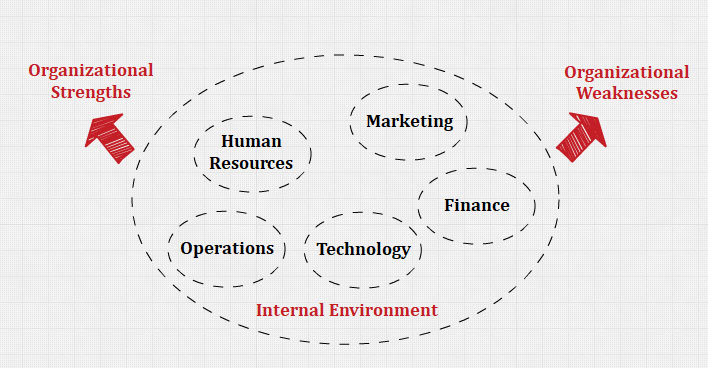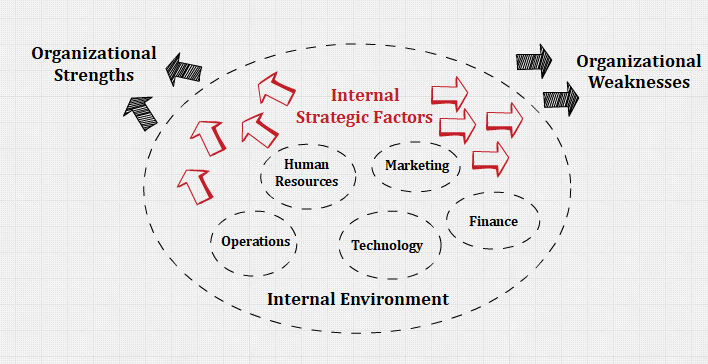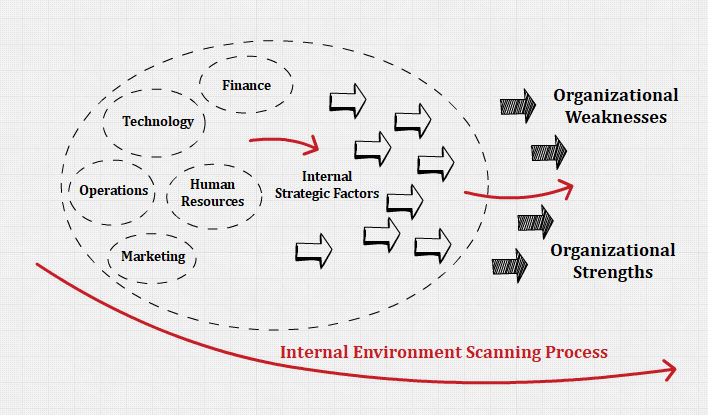The Analysis of Internal Environment

The analysis of the internal environment of a firm refers to the understanding of its strengths and weaknesses in the functional areas of its business.
No enterprise is equally strong or weak in all areas. Internal strengths and weaknesses, coupled with external opportunities and threats, and a clear statement of mission, provide the basis for establishing objectives and strategies.
One of the reasons for firms to analyze their internal organization is that in the modern business world, having common resources and capabilities alone is not likely to be the source of competitive advantage.
Traditionally, common resources and capabilities play a critical role in a firm’s efforts to produce, sell, and distribute products and services, such as labor costs, access to financial resources and raw materials, and protected or regulated markets.
As the economy progresses, there is an increasing number of firms start using their strategic resources to form core competencies. Through these competencies, firms successfully implement a strategy as a means of overcoming the advantages created by deploying common resources alone.
The key objective firms seek when they analyze their internal organization is to understand how to leverage their unique bundle of resources and capabilities.
Being able to leverage the relationships and integration among resources, strategic resources, capabilities, competencies, core competencies, and distinctive competencies can lead to strategic competitiveness and sustainable competitive advantage.
To analyze its internal organization, a firm must follow an internal environment scanning process to examine its entire portfolio of resources and capabilities and understand its internal strategic factors.
Internal Strategic Factors

Internal strategic factors are strengths and weaknesses that are likely to determine whether a firm will be able to take advantage of opportunities and avoid threats presented in the external environment and thus formulate proper strategies.
Internal strategic factors consist of resources, capabilities, and competencies.
Resources, capabilities, and competencies are the foundation of competitive advantage. Resources are bundled to create capabilities. In turn, capabilities become the sources of a firm’s competencies, which are the basis of establishing competitive advantages for the firm.
Internal Environment Scanning Process

An internal environment scanning process focuses on the objective of identifying and evaluating the strengths and weaknesses of a single firm.
This process is sometimes called organizational analysis.
The process of internal environment scanning consists of 3 steps in which a firm: (1) gather its resources and capabilities, (2) evaluate to find internal strategic factors, and (3) classify those factors into strengths and weaknesses.
The process starts with the firm’s understanding of the importance of its resources, strategic resources, capabilities, competencies, and core, and distinctive competencies. The firm then must evaluate this portfolio and determine which ones are internal strategic factors. These internal strategic factors are classified as internal strengths and weaknesses that in turn will help determine the future of the firm.
Activity 1: The gathering activity of this process requires assimilating information about the firm’s management, marketing, finance/accounting, production/operations, research and development (R&D), and management information systems operations.
Activity 2: The evaluation activity of this process can be done by comparing factors with (1) the organization’s past performance, (2) the organization’s key competition, and (3) the industry as a whole. If the factor is significantly different from its past experience in the firm, its key competitors, or the industry standard, then it is likely to be an internal strategic factor.
Activity 3: The classification activity of this process requires representative managers and employees from throughout the firm to be involved in determining a firm’s strengths and weaknesses.
The Challenge of Analyzing Internal Environment

The strategic decisions that a firm makes about its internal environment can be as challenging and difficult as any other type of decisions management typically involves.
Making these decisions involves identifying, developing, deploying, and protecting resources, capabilities, and competencies. They are about choices with large impacts that firms need to understand and leverage properly. Making such choices would require unified knowledge and participation from people at many different levels of the organization.
Making these decisions also faces uncertainty because of a number of issues, including those of new proprietary technologies, rapidly changing economic and political trends, transformations in societal values, shifts in customers’ demands, or trends in the environmental landscape.
Making these decisions also faces complexity because of the interrelationship between these involved factors. This natural tendency exponentially increases the range of issues firms must resolve when they try to take on these challenges.
Making these decisions may be shadowed by the intra-organizational conflict that occurs regarding which resources are strategic to the firm, which combination of resources and capabilities are considered core competencies, or which distinctive competencies a firm should develop and nurture.
Making these decisions may also be biased due to pressure on management to pursue short-term decisions that help the firm meet anticipated quarterly earnings, making it more difficult to accurately examine the firm’s internal environment, strategic resources, capabilities, and core competencies.
Judgment is required in order to overcome these challenges.
Judgment is the capability of making successful decisions when no obviously correct model or rule is available or when relevant data are unreliable or incomplete.
In such situations, firms must be aware of possible cognitive biases, such as overconfidence. Individuals who are too confident in the decisions they make about how to use the firm’s resources may fail to fully evaluate contingencies that could affect those decisions.
Firms must also take intelligent risks as it makes judgment calls. In the current competitive landscape, executive judgment can become a valuable capability. Over time, effective judgment allows a firm to build a strong reputation and retain the loyalty of stakeholders whose support is linked to above-average returns.
Firms must also find individuals who can make the best judgment about using the organization’s resources, capabilities, and core competencies, even though this task can be a challenge.
Individuals holding these key decision-making positions are called strategic leaders. Strategic leaders as individuals with an ability to make effective decisions when examining the firm’s resources, capabilities, and core competencies for the purpose of making choices about their use.
This is important because the quality of leaders’ decisions regarding internal strategic factors can have a huge impact on the firm’s decision-making process.
The involvement of managers and employees from different functions and divisions can help firms resolve these challenges.
Through involvement in performing an internal environment scanning, managers and employees from different functions and divisions of the firm come to understand the nature and effect of decisions in other functional business areas in their firm. They are also provided with more opportunities to understand how their jobs, departments, and divisions fit into the whole organization.
Knowledge of these relationships is critical for effectively overcoming obstacles in internal environment scanning and establishing objectives and strategies. Also, managers and employees generally perform better when they understand how their work affects other areas and activities of the firm.
The number of relationships among the functional areas of business increases dramatically with a firm’s size, diversity, geographic dispersion, and the number of products or services offered.
Financial ratio analysis is a great tool to exemplify the complexity of relationships among the functional areas of business. A declining return on investment or profit margin ratio could be the result of ineffective marketing, poor management policies, research and development errors, or a weak management information system.
In organizations that do not use strategic management, marketing, finance, and manufacturing managers often do not interact with each other in significant ways, and thus fail on these communication lines.
In organizations that place too great of an emphasis on one function at the expense of others, this thinking is also detrimental to resolves the problems in the internal environment scanning process and generally, the strategic management process.
Resources
Further Reading
- Internal Analysis: What is It? (zippia.com)
- Internal Environment Factors Analysis (higherstudy.org)
- How to Conduct a Thorough Internal Analysis (indeed.com)
- Internal Factors that May Affect the Business Organization (pestleanalysis.com)
- Resource Based View (strategicmanagementinsight.com)
- Using the Resource-based View Strategy for a Competitive Advantage (saviom.com)
- The Resource-Based View of the Firm (oxfordre.com)
- Resource-Based View (businessballs.com)
Related Concepts
- Business Internal Environment Factors
- Organizational Capabilities
- Functional Resources and Capabilities
References
- Hitt, M. A., Ireland, D. R., & Hoskisson, R. E. (2019). Strategic Management: Concepts and Cases: Competitiveness and Globalization (MindTap Course List) (13th ed.). Cengage Learning.
- Hill, C. W. L., & Jones, G. R. (2011). Essentials of Strategic Management (Available Titles CourseMate) (3rd ed.). Cengage Learning.
- Mastering Strategic Management. (2016, January 18). Open Textbooks for Hong Kong.